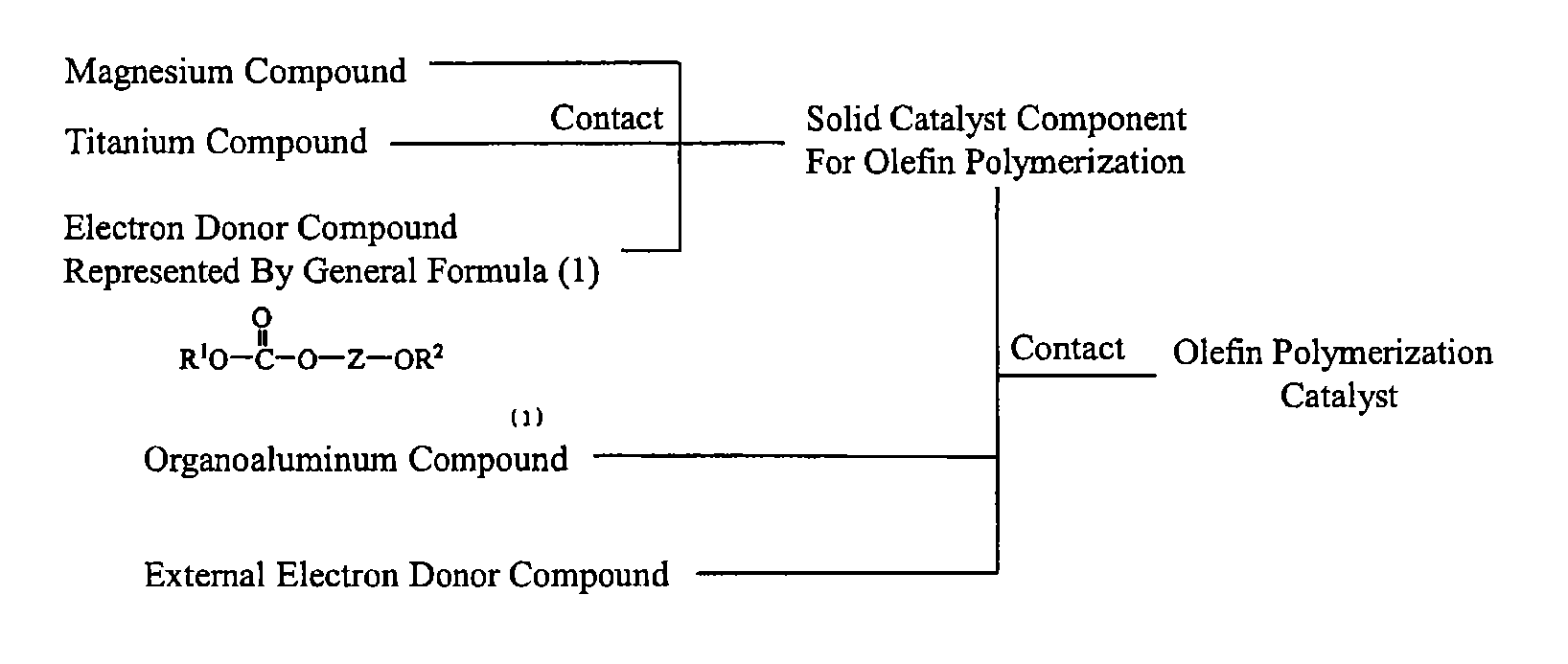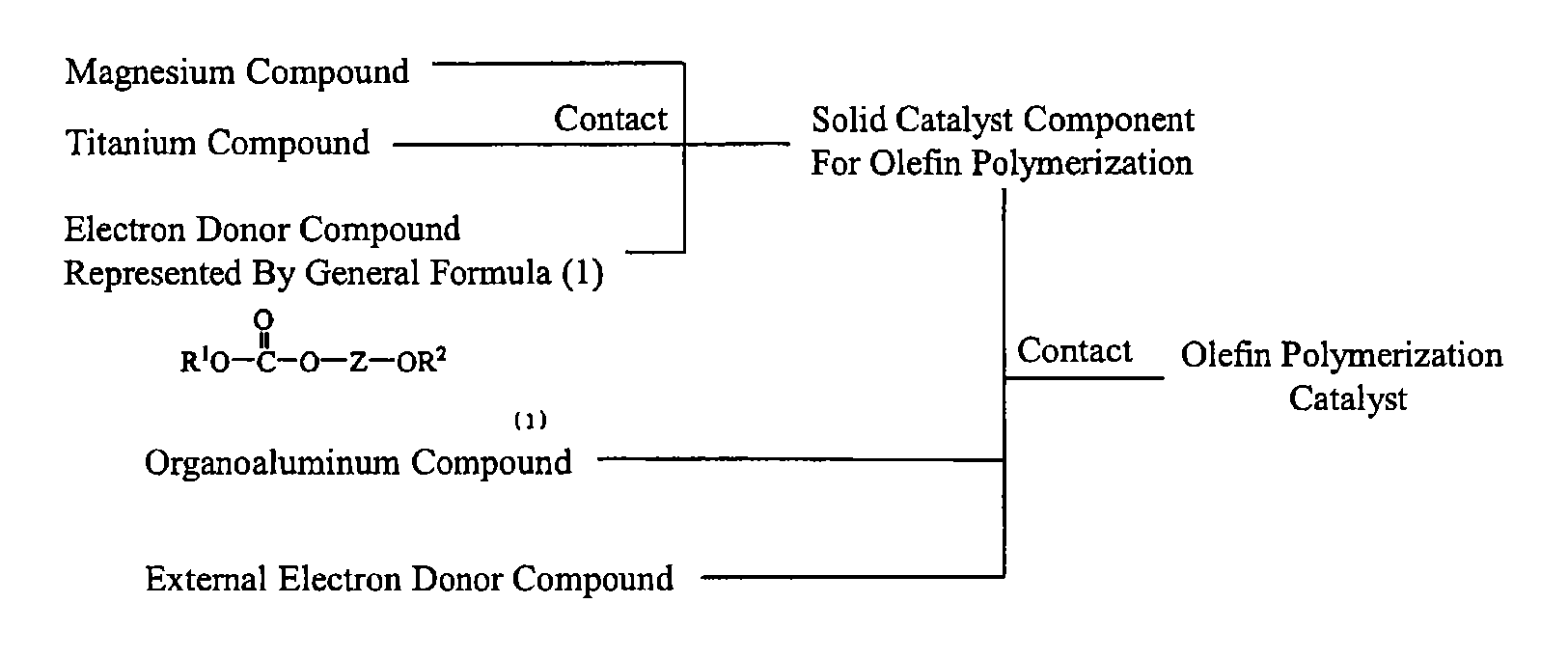Solid catalyst component for polymerization of olefin, catalyst for polymerization of olefin, and method for producing olefin polymer
a technology of solid catalyst and polymerization catalyst, which is applied in the field of solid catalyst components for olefin polymerization, an olefin polymerization catalyst, and a, can solve the problems that the electron donor does not necessarily ensure satisfactory polymerization activity and stereoregularity, and achieves moderate molecular weight distribution, high yield, and high stereoregularity.
- Summary
- Abstract
- Description
- Claims
- Application Information
AI Technical Summary
Benefits of technology
Problems solved by technology
Method used
Image
Examples
production example 1
Synthesis of 2-ethoxyethyl-1-phenyl carbonate
[0112]50 g of phenyl chloroformate and 33 ml of 2-ethoxyethanol were dissolved in 300 ml of dichloromethane. After cooling the solution to 0° C. using ice water, 48 ml of triethylamine was added dropwise to the solution over 30 minutes. After the dropwise addition, the mixture was slowly heated to room temperature over 1 hour, and reacted for 12 hours. After completion of the reaction, the reaction product was purified by column separation and distillation to obtain 21 g of a product.
[0113]The product was subjected to 1H-NMR analysis, and it was found that the 1H-NMR chemical shift values were 1.25 (t, 3H), 3.58 (q, 21-1), 3.73 (m, 2H), 4.40 (t, 2H), 7.17-7.41 (m, 5H). It was thus confirmed that the product was 2-ethoxyethylphenyl carbonate. The purity of the resulting 2-ethoxyethyl-1-phenyl carbonate determined by GC was 96.9%.
production example 2
Synthesis of 2-benzyloxyethyl-1-phenyl carbonate
[0114]50 g of phenyl chloroformate and 51.9 g of 2-benzyloxyethanol were dissolved in 300 ml of dichloromethane. After cooling the solution to 0° C. using ice water, 48 ml of triethylamine was added dropwise to the solution over 30 minutes. After the dropwise addition, the mixture was slowly heated to room temperature over 1 hour, and reacted for 12 hours. After completion of the reaction, the reaction product was purified by column separation and distillation to obtain 28 g of a product.
[0115]The product was subjected to 1H-NMR analysis, and it was found that the 1H-NMR chemical shift values were 3.73 (m, 2H), 4.40-4.50 (m, 4H), 7.17-7.48 (m, 10H). It was thus confirmed that the product was 2-benzyloxyethyl-1-phenyl carbonate. The purity of the resulting 2-benzyloxyethyl-1-phenyl carbonate determined by GC was 97.5%.
production example 3
Synthesis of 2-ethoxyethyl-1-methyl carbonate
[0116]100 g of 2-ethoxyethanol was added dropwise to a mixture of 700 g of dimethyl carbonate and 230 g of potassium carbonate at 25° C. in a nitrogen atmosphere. The mixture was stirred for 16 hours, and filtered. The filtrate was concentrated, and purified by vacuum distillation to obtain 74 g of a product.
[0117]The product was subjected to 1H-NMR analysis, and it was found that the 1H-NMR chemical shift values were 1.16 (t, 311), 3.49 (q, 2H), 3.60-3.63 (m, 2H), 3.74 (s, 3H), 4.22-4.27 (m, 2H). It was thus confirmed that the product was 2-ethoxyethyl-1-methyl carbonate. The purity of the resulting 2-ethoxyethyl-1-methyl carbonate determined by GC was 99.0%.
PUM
| Property | Measurement | Unit |
|---|---|---|
| molecular weight distribution | aaaaa | aaaaa |
| temperature | aaaaa | aaaaa |
| scattering particle size distribution analyzer | aaaaa | aaaaa |
Abstract
Description
Claims
Application Information
 Login to View More
Login to View More - R&D
- Intellectual Property
- Life Sciences
- Materials
- Tech Scout
- Unparalleled Data Quality
- Higher Quality Content
- 60% Fewer Hallucinations
Browse by: Latest US Patents, China's latest patents, Technical Efficacy Thesaurus, Application Domain, Technology Topic, Popular Technical Reports.
© 2025 PatSnap. All rights reserved.Legal|Privacy policy|Modern Slavery Act Transparency Statement|Sitemap|About US| Contact US: help@patsnap.com



